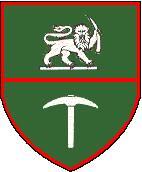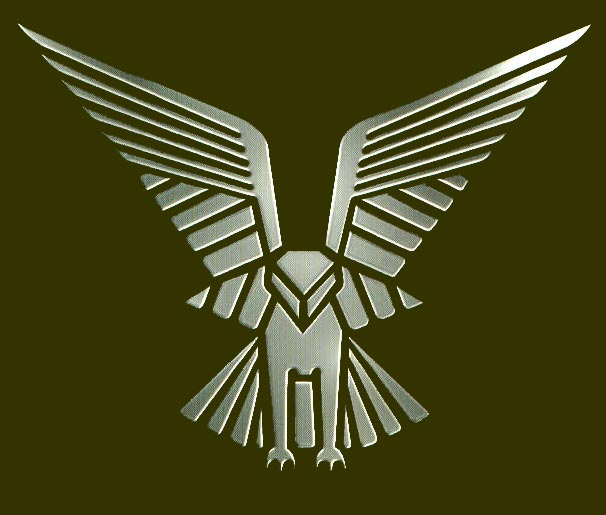|
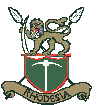
| |
Attacks on Terrorist Camps
SECTION 1: INTRODUCTION
General
- It is difficult to lay down a uniform drill for a preplanned attack which
will apply on all occasions, because terrorist tactics and the type of
location used vary considerably from area to area. On the other hand, the
suggested drills can easily be amended to suit different circumstances and
can be used as a basis for initial planning.
- Deliberate attacks are prepared from information gained from air photo-
graphs, prisoners, informers or patrols. There are occasions, however, when
a deliberate attack can be art immediate reaction to an unexpected favorable
situation. Deliberate attacks may therefore be preplanned or
immediate.
- The main considerations to be borne in mind are surprise and speed.
- Surprise can be achieved by:
- Security in all stages of planning.
- Detailed planning and preparation.
- Preparing an alternative method of execution.
- Concealment of approach and positioning of forces.
- A well-executed plan with maximum aggression.
- Speed is essential to obtain surprise and can be achieved by:
- Avoiding unnecessary delay in the planning stage.
- Rapid deployment of troops. (It may be necessary to use
helicopters, but alerting the enemy by such movement should be
avoided.)
- The probability of eliminating large numbers of terrorists by means of a
deliberate attack is fairly small. Their mobility, the lack of information
concerning their combat and resting positions, which are essentially
flexible, and the aid which they receive from the population, make it
difficult to plan in detail. Their efficient system of intelligence also
makes it extremely difficult to achieve surprise.
- Although the example outlined below is concerned with a daylight attack on
a terrorist camp, this does not preclude the possibility of attacking at
night. The basic principles remain the same, although follow-up actions are
normally only feasible during daylight hours.
Terrorist Tactics
- It cannot be assumed that terrorists will automatically abandon their
camp. Experience has shown that on occasions terrorists have opposed attacks
in an aggressive manner from well-prepared positions.
- The main factor to be borne in mind is that terrorist sentries will be
alert and will give warning of any suspicious movement. By day it will be
difficult to get past them. A study of terrorist habits has revealed that
they position their sentries as follows:
- Usually, sentries are posted on likely approaches to the camp.
- At night, sentries are posted in close proximity to or within the
perimeter of the camp.
The terrorists have been known to mine and booby trap possible approaches
as an additional precaution.
SECTION 2: PLANNING AND PREPARATION
- Introduction. To ensure a successful operation,
the planning and preparation for such an operation are most important. When
speed is essential for success, it may be necessary to sacrifice security to
a certain extent. The commander concerned must carefully consider this
aspect when making his appreciation.
- Appreciation. Depending on the time available,
the commander responsible for the operation must make a careful, detailed
appreciation based on the task. This appreciation must include such factors
as the enemy, the local population, the terrain and own forces.
- Enemy. in the appreciation, points regarding the
enemy which must be taken into consideration are the following:
- Nature and strength.
- Routes both in and out normally used by the enemy.
- In and out timings normally used by the enemy for his movement to and
from the objective.
- security measures such as location and routine of sentries, defensive
system, patrols, sighting of weapons, alert and alarm systems, etc.
- Normal reactions to security force presence.
- Possible additional or external support that may be provided.
- Local population. When considering the local
population, the following aspects must be considered:
- Density and concentration.
- The nature and type of the village or settlement and its location in
relation to the objective.
- The attitude of the local population towards both the enemy and
security forces.
- The daily routing of the local population and routes or paths normally
used by them to their cultivations and water points.
- Terrain. when considering terrain, the following
aspects must be borne in mind:
- Nature and size and exact location of the objective.
- Nature of the terrain around the objective, this to include:
- Position in relation to the objective.
- observation and fields of fire.
- Obstacles, either natural or man-made.
- Cover and concealment.
- Approaches and exit/escape routes.
- Check points.
- Sources of information. The above information
about the terrain can be obtained by the following means:
- Patrolling.
- Air and ground reconnaissance.
- Maps and air photographs.
- Local population, police, informers or captured enemy, etc.
- Timings. In determining H-hour, the following
aspects must be considered:
- Time available in which to carry out the operation.
- Distances to be covered by attacking force.
- Using cover of darkness for approach march for maximum security.
- Enemy sentry routine, i.e., early morning when sentries may not yet
have been posted or are still sleepy from the night before, or at last
light when sentries may be withdrawn.
- Taking advantage of bad weather conditions, rest and meal times.
- The possibility of attacking during the hours of darkness, bearing in
mind the attendant advantages and disadvantages.
- Routes. When considering the approach and
withdrawal routes, the following should be borne in mind:
- Distances to be covered by the various groups.
- Secrecy and security.
- Nature of the route, i.e., easy or difficult going.
- Own forces. In dealing with own forces, the
following must be considered:
- Aim and nature of operation.
- Enemy strength, security measures and possible external support.
- Nature and size of objective.
- Forces available, their experience and standard of training.
- Plan. As a result of this appreciation, the plan
could include the following:
- Employment of troops.
- Timings.
- Approach and withdrawal routes.
- Strength, equipment and additional support which may be required.
- Standard of planning and preparation. only with
good planning and preparation can the success of the operation be ensured.
- Security. These activities must be carried out
under strict discipline in order to maintain secrecy and to provide the
force involved with a detailed knowledge of the operation.
- Training, leadership and initiative.
Notwithstanding the fact that an operation may be well planned in all its
detail, the unexpected may often occur and then the standard of training,
leadership and initiative are of prime importance. Should the presence of
the military forces be discovered before all groups are in position and the
assault is ready to commence, then clear direction must be given to each
group as to what actions it should take.
SECTION 3: COMPOSITION: ATTACK FORCE
- Groups. On each occasion when a deliberate
attack is being planned, there is a requirement for the military forces to
be broken down into a number of groups. Ideally the attacking force should
consist of the following groups, which can, normally, be found in a rifle
company:
- Stop groups.
- Fire/cover groups.
- Assault group.
- Command group.
- Follow-up group.
- Reserve.
- Essential/combined groups. It may not always be
possible to achieve this breakdown with the troops available. The command
and assault groups will always be necessary. Through necessity other groups
can combine certain of their roles, e.g., the fire group could also be
detailed as the follow-up group.
- Employment of groups. All plans should be based
on the correct use of these groups. Examples of their employment and
handling are as follows:
- Stop groups.
- Task. To prevent the enemy from escaping.
- Deployment.
- They must be deployed at such a distance from the camp so as
not to prejudice the secrecy of the operation.
- The strength and number of stop groups to be deployed is
dictated by the terrain, the enemy and circumstances prevailing
at the time, but, if possible, they should be based on sticks of
four or five men covering all likely escape routes from the
objective.
- Careful briefing is necessary and the following should be
borne in mind:
- If possible, before a target is engaged it should be
identified.
- Stops should be in concealed positions.
- Each stop group should know the position of its neighbors.
- Individual stops should not move from their positions
until ordered to do so. However, should this, for some
reason, become necessary, the stop or stops must ensure that
those on their flanks know what is happening.
- Stop groups should be equipped with radios.
- The stop groups should always be positioned before the
assault takes place. If this is not possible, simultaneous
positioning is acceptable.
- The best position for the stop groups will normally
dictate the direction of assault.
- The fire/cover group.
- Tasks.
- To open fire on the objective with every available weapon.
- To give fire support to the assault group. c. If necessary, to
prevent interference from external reinforcements.
- Deployment.
- The fire group should approach as near as possible to the
camp, undetected.
- The principle of bringing maximum fire to bear on the camp
must be balanced against the difficulty of moving too large a
body of men through the bush without alerting the enemy, and it
may, on occasions, be necessary to reduce the strength of this
group and increase the ratio of automatic weapons.
- The assault group. A proportion of the enemy
will normally survive and it is therefore essential to have an assault
group, which has not been tied down by the initial firefight, for the
assault. Its tasks and Organization are as follows:
- Tasks.
- To eliminate the sentries who guard the objective.
- To skirmish forward and penetrate the objective to kill or
capture terrorists, and, if necessary, conduct an immediate
limited follow-up to maintain contact with, and pressure on,
escaping enemy. In this event careful control and coordination
with stop groups is essential.
- To search for hidden personnel, documents or material.
- To ascertain by a 360-degree search of the perimeter whether
any terrorists have escaped.
- To demolish, if necessary, enemy explosives and booby traps.
- Organization. Bearing in mind the above tasks,
the assault group should be organized into the following teams:
- Sentry eliminating team.
- Assault team (the strength depends upon the nature of the
objective).
- Support teams.
- Demolition teams.
- Search team (including trackers).
The above Organization is temporary and may not be necessary
in every case. one team, having accomplished its task, can
reinforce another team or receive another task.
- The command group. A small command group should be positioned so as to
control the attack. This group will consist of the commander accompanied
by an escort, his radio operator, medical orderly and interrogator, if
one can be made available. It may be necessary at some stage of the
battle for the commander to get airborne in order to assess and control
the overall situation.
- Follow-up group. The task of the follow-up group is self-explanatory.
However, before any follow-up is commenced, sufficient time must be
allowed for the assault group to complete its 360-degree search for
tracks and for any terrorists who escape to reach the stop positions.
Any follow-up should be carefully coordinated and the stop troops warned
of the direction. This group may well be found from the assault group,
fire group or reserve. This group should not be less than one section in
strength. It must have a radio, tracker and responsible commander.
- Reserve. A reserve is desirable and, if possible, should be positioned
nearby to enable a rapid deployment by any means including the use of
helicopters. Tasks are as follows:
- Reinforce the assault group, if necessary.
- Reinforce any of the stop groups who may become involved in a
prolonged engagement.
- Act as a follow-up group.
- Cover the withdrawal of the attacking force, if necessary.
- Act as additional stop or fire groups.
- Collect and escort prisoners.
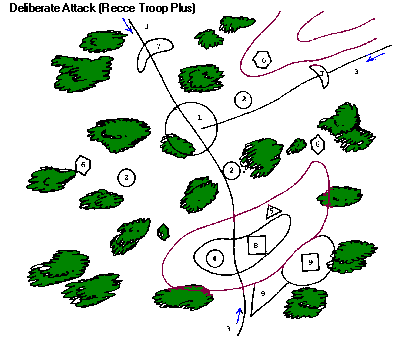
Legend
- Objective terrorist camp in heavy bush.
- Enemy sentries (assault group closes as close as possible).
- Direction of possible enemy reinforcements.
- Platoon commander and observation team.
- Assault group - two or more teams.
- Stop groups.
- Fire cover groups - to stop reinforcements.
- Reserve group - to assist assault group or stop group.
- Follow-up group.
Any of the groups to also secure rear of command.
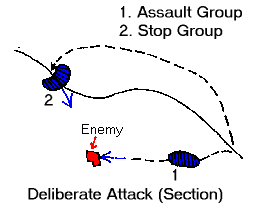
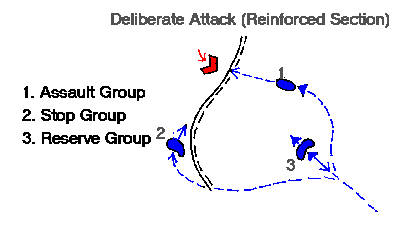
- Air support. When planning a deliberate attack, cognizance
must be taken of the air support which is available. However, it
must be remembered that the use of air support, prior to the attack, may
prejudice surprise.
- Light aircraft. This type of aircraft is particularly useful and can
be employed in the following roles:
- Armed air support. In certain circumstances, the initial assault
on the objective may be more effectively carried out by aerial
attacks using guns and/or rockets, bombing or, at a later stage, in
support of stops or follow-up groups.
- Reconnaissance.
- Radio relay.
- Airborne control.
- b. Helicopters. Roles to be considered are:
- Aircraft and stick(s) of troops on immediate standby as a mobile
reserve for redeployment to counter unexpected moves by terrorists
or to reinforce, deploy or redeploy stops.
- Airborne control.
- Evacuation of casualties, terrorists and material.
- Fire support.
- Preventing the enemy from escaping in selected area.
- Fighter ground attack or bombers. In certain circumstances, the
initial assault on the objective may be more effectively carried out by
aerial attack using front guns and/or rockets or bombing. An attack of
this nature requires detailed coordination, particularly regarding
timing and safety distances. All groups should be equipped with
ground-to-air communications.
- Fire support. If available, artillery and mortar support should be
considered. In the event of their being used, fire controllers should
accompany the command group. Safety and loss of surprise are, however,
limiting factors.
SECTION 4: SEQUENCE OF ACTION
- Sequence and timings. In ideal circumstances the
following sequence of action and timing is recommended:
- The force commander issues detailed orders to all participants,
ensuring that every man knows precisely what his task or tasks will be,
as well as those of other groups.
- Night D-l/D. During the night the force moves to a waiting area
preselected at a suitably secure distance from the objective. The stops
move off and take up their positions; in some cases this might be
difficult and final adjustments might have to be made to their positions
just after first light.
- D-day.
- Stops use the fifteen minutes (or more if necessary) just after
first light to adjust their final positions. All other groups move
forward to their selected positions before first light.
- At H-hour, fire is opened on the objective on the order of the
force commander.
- The assault group skirmishes forward and clears the camp area.
They carry out a thorough search and also try to ascertain whether
any terrorists have escaped and in which direction.
- The stops engage any escaping terrorists who approach their
positions.
- Immediate interrogation of captured enemy and local population
must be carried out.
- The force commander must then decide from the available
information to:
- Start following up tracks from the camp while the stops remain
in position.
- Withdraw the stops to a prearranged rendezvous and then start
the follow-up.
- Order the stops to patrol either left or right to the next
stop position to check whether the terrorists have crossed the
stop line. If tracks are found, to start an immediate follow-up.
- The force commander should, if necessary, plan an area ambush on
the camp area.
- Platoon attack. manpower limitations within the
platoon will normally prohibit the formation of all the groups detailed
above. Nevertheless, at times it may be necessary to carry out a deliberate
attack at platoon level.
- Platoon follow-up. If a
follow-up becomes
necessary, this should, in the average case, be undertaken by the entire
platoon. Further troops would then be required for ambushing the objective,
if necessary.
SECTION 5: DELIBERATE ATTACKS AIDE MEMOIRE
Situation
- Terrain.
- Nature of ground.
- Details regarding the objective.
- Enemy forces.
- Expected strength.
- Weapons carried and possible fields or arcs of fire. Include light
machine-gun positions if known.
- Objective routine and location of sentries, if known.
- Possible escape routes.
- Names of key enemy personnel., if known.
- Local inhabitants.
- Location of villages, settlements, etc.
- Attitude towards security forces or enemy.
- Habits and movements.
- Friendly forces.
- Other troop movements in the area, if applicable.
- Tasks of other forces engaged in the operation, if on a large scale.
- Attachments and detachments (if applicable). Attached to the attacking
force for the duration of the operations, e.g.:
- Helicopter or light aircraft in support.
- Special trackers or tracking teams, including dogs, for the follow-up,
etc.
Mission
- To kill or capture all the terrorists occupying the camp at grid
reference.
Execution
- General outline. A brief outline or general description as to how the plan
is to be executed.
- Detailed tasks.
- Positions of groups.
- The specific task of each group.
- Direction of fire, and arcs of fire of each group.
- Coordinating instructions.
- Timings. Including:
- H-hour.
- Waking time.
- Time to assemble for last minute check/briefing.
- Departure times for each group.
- Time when groups must occupy final positions.
- Assembly area for the force, if necessary.
- Dispersal point (frequently in the assembly area).
- Assembly area for the assault group.
- Routes for whole force and for each group to its final position.
- Formations and order of march from assembly area to dispersal point
and to final position.
- Final actions and instructions at dispersal point.
- Security and deception plan.
- Action should local inhabitants be encountered during move in.
- Orders to commence firing, to fire cover group, stop groups and
assault group.
- Orders for cease firing.
- Action if discovered by enemy sentries and warning is given.
- Orders for follow-up.
- Details regarding search of areas of enemy camp.
- Rendezvous for assault force after completion of attack.
- Action should enemy resistance be stronger than anticipated.
- Posting of sentries after attack during mopping up and search phase.
- Immediate interrogation of captured terrorists. (Interpreters should
be available.)
- Use of air.
- Limit of follow-up.
Administration and Logistics
- Dress, equipment, weapons and ammunition to be carried.
- Use of transport, if applicable.
- Rations and water.
- Medical.
- Treatment and handling of own and enemy casualties.
- Evacuation of own and enemy casualties.
- Medical personnel and stretchers to assaulting force.
- Handling of enemy captured and killed, including method of evacuation.
- Handling of all enemy equipment, weapons and documents captured.
- Establishing an administration area, if necessary, for extra equipment and
kit and members who may not be required for the actual assault.
- Final inspection and checking of personnel, weapons and equipment.
Command and Signals
- Radio communications.
- Frequencies, establishing contact and switching on.
- Call signs, including air.
- Final test of radios and check of radio net.
- Location of commander or headquarters.
- Prior to the assault.
- During the assault.
- After the assault.
- Signals. Signals for the:
- Attack.
- Cease-fire.
- End of operation; all close in to rendezvous.
- Identifications for follow-up group.
- Nickname and/or code words.
|
|
